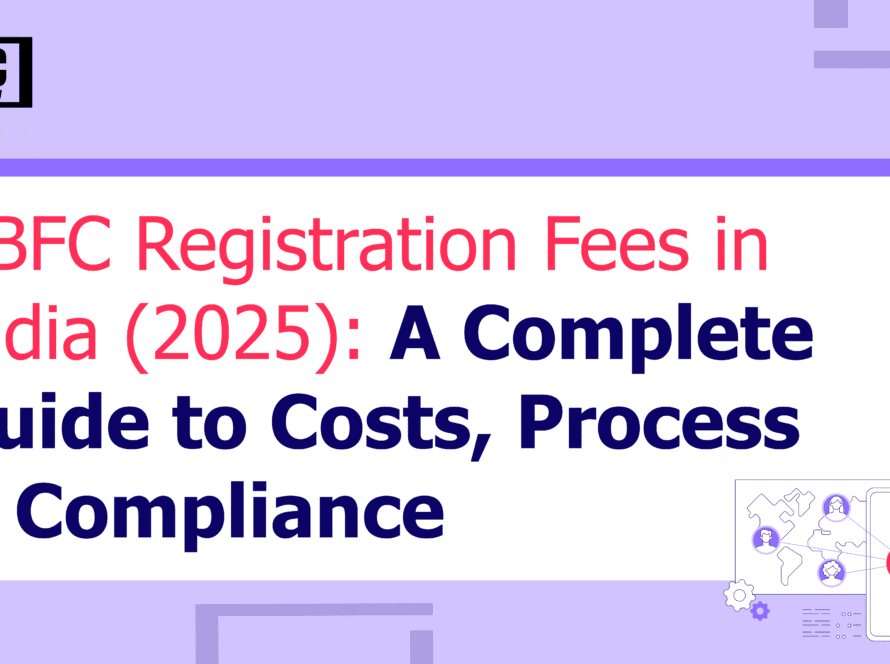Inside This Article
Non-Banking Financial Companies (NBFCs) have become an essential part of the financial system in India. They offer various services like loans, asset financing, and wealth management. If you’re planning to start an NBFC or seeking to understand the registration process in India, you’ve come to the right place. This guide will help you understand the steps, rules, and documents needed to register an NBFC in India.
What is an NBFC?
An NBFC is a financial institution providing banking services without a banking license. These companies work like banks. They give loans, offer credit, and help people invest their money. However, they cannot accept demand deposits or issue cheques like commercial banks. They help people who don’t have easy access to banks, like those in small towns or with low income, get the money and financial help they need.
Related Post: NBFC Registration: A Practical Guide for First-Time Entrepreneurs (2025)
Why Register as an NBFC?
Registering as an NBFC is essential for those who wish to conduct non-banking financial services legally. The Reserve Bank of India (RBI) manages the registration process to make sure only trusted and capable companies are allowed to run NBFCs. It brings credibility to the company, enabling it to build trust with clients and investors. Additionally, RBI-regulated NBFCs are better positioned to receive funding from financial institutions.
The NBFC Registration Process
The process of registering an NBFC is meticulous and involves several stages. You need to know the rules and money requirements set by the RBI to get your company registered. Here’s a breakdown of the key steps involved.
1. Eligibility Criteria for NBFC Registration
To apply for NBFC registration, your company must meet certain eligibility criteria set by the RBI. These include:
- Company Registration: Your business must be registered under the Companies Act, 2013.
- Net Owned Fund (NOF): Before you can register a new NBFC, the RBI insists you have a minimum amount of your own capital ready up front.
Required NOF levels:
- Investment & Credit Companies (ICC), Microfinance Institutions (MFI) and Factors: ≥ ₹ 10 crore
- Peer-to-Peer platforms (P2P), Account Aggregators (AA) and NBFCs that neither take public deposits nor serve retail customers: ≥ ₹ 2 crore
How to calculate NOF
(paid-up equity + free reserves) − (accumulated losses + intangible assets)
NOF therefore represents the company’s true owned funds—after writing off losses and intangible assets—ensuring your NBFC starts with a solid financial foundation.
- Business Plan: You must provide a clear and detailed plan for the next five years. It should explain your financial goals, who your customers will be, and how you plan to grow your NBFC during that time.
- Experience of Directors: At least one-third of the company’s directors must have expertise in the financial sector.
- Credit Rating: Your company must have a credit rating that meets the RBI’s prescribed standards.
2. Types of NBFCs
Before applying, you must decide on the type of NBFC you wish to establish. There are several categories of NBFCs, including:
- Deposit Accepting NBFCs (NBFC-D): These companies can accept deposits from the public, similar to banks.
- Non-Deposit Accepting NBFCs (NBFC-ND): These companies do not accept public deposits.
- Micro-Finance Institutions (NBFC-MFI): Specializing in providing small loans to low-income individuals.
- Asset Finance Companies (AFCs): Focused on helping with financing for buying assets such as vehicles and machinery.
- Infrastructure Finance Companies (IFCs): Focused on financing infrastructure projects.
- Systemically Important Core Investment Companies (CIC-ND-SI): These companies mainly invest in shares of other companies. They hold a lot of their money in these shares rather than in other assets.
To ensure a smooth registration process, you will need to submit a range of documents. These include:
- Proof of Company Registration: A certified copy of your company’s incorporation certificate.
- Memorandum and Articles of Association: These are key documents that explain what the company does, how it is set up, and the rules for running it.
- Board Resolution: A resolution from the company’s board, certifying its decision to apply for NBFC registration.
- Net Owned Fund Certificate: A certificate from the statutory auditor confirming your company’s NOF.
- Business Plan: A clear plan showing how the company expects to earn, spend, and grow over the next five years. It includes future income, expenses, profits, and how money will flow in and out.
- PAN and CIN: A copy of the company’s Permanent Account Number (PAN) and Corporate Identity Number (CIN).
- Directors’ Profiles: Signed profiles of all company directors.
- Credit Reports: CIBIL or credit reports for all directors.
- Office Location Proof: Documents verifying the address of your company’s registered office.
3. Steps Involved in NBFC Registration
Once your company meets all the rules and has all the necessary documents ready, the next step is to apply to the RBI to get registered as an NBFC. Here are the steps involved:
- Step 1: Visit the RBI Portal: Start by visiting the RBI’s official website and accessing the NBFC registration section.
- Step 2: Fill Out the Application Form: Complete the application form relevant to the type of NBFC you wish to establish. Ensure that all information is accurate and complete.
- Step 3: Submit Documents: Upload the required documents in the prescribed format.
- Step 4: After you submit your application, you’ll get a CARN (Common Application Reference Number) as a confirmation. Keep this number safe for future reference.
- Step 5: Send paper copies: After you apply online, you must also send the printed forms and documents to the RBI’s office in your area.
- Step 6: RBI Verification: The RBI will verify your documents for compliance. If any discrepancies are found, the application may be rejected.
- Step 7: Get Your Certificate: If the RBI approves your application, they will give you a registration certificate. After that, you can officially start your NBFC business.
4. Post-Registration Compliance
After successfully registering your NBFC, you must adhere to certain regulatory norms set by the RBI. These include:
- Maintaining NOF: You must maintain the prescribed minimum NOF at all times. The RBI may impose penalties if this requirement is not met.
- Quarterly and Annual Returns: It’s mandatory to file quarterly and annual returns with the RBI.
- Fair Practices Code: You must follow clear and honest rules in your work. This helps keep your NBFC fair and trustworthy.
- KYC and AML Compliance: Adherence to Know Your Customer (KYC) and Anti-Money Laundering (AML) norms is essential.
- Credit Information Sharing: You must share your customers’ loan and credit details with credit bureaus (CICs).
- Periodic Due Diligence: You need to conduct regular internal checks and audits to make sure your company follows RBI rules.
5. Challenges and Considerations
While registering as an NBFC offers great opportunities, the process comes with its challenges. Some of the common hurdles faced by applicants include:

- Capital Requirements: It can be tough for new companies to meet the minimum required ₹5 crore for NOF, which will rise to ₹10 crore by 2027.
- Compliance Costs: Filing reports, audits, and following RBI rules can be expensive for small businesses.
- Approval Time: The registration process may take a few months because the RBI carefully reviews each application.
Our Article: How to set up your NBFC- Registration, Operational manual, Licensing, and more
Conclusion
Starting an NBFC in India can be a great business idea, but it needs careful planning, following rules, and having good financial backing. At NBFC Advisory, we help you through each step, from meeting the requirements to submitting documents and following RBI rules. With changes in the Net Owned Fund rule, it’s important to make sure your company has enough funds. Knowing the process well can help you avoid delays.
Getting advice from experts at NBFC Advisory can make everything easier and faster.
Book a free Consultation —let’s get your NBFC journey started, the right way.
📞 Call NBFC Advisory:+91 93287 18979
🌐 Visit: nbfcadvisory.com









1 Comment
guitar
Thank you for the auspicious writeup It in fact was a amusement account it Look advanced to far added agreeable from you However how can we communicate